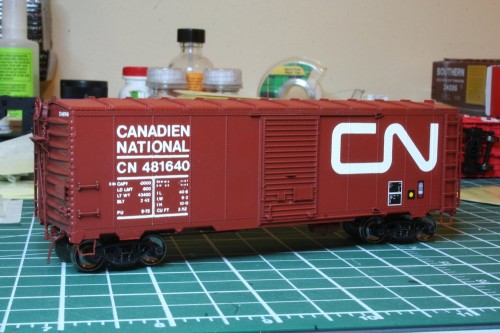This is a project I pulled out of the pile on the back burner.


This boxcar was an undecorated Intermountain model of a 10’0″ interior height boxcar, which I painted some time ago, and started work on the lettering, but then it got left aside.
The model was assembled from the kit as intended, except I also added a small piece of .020x.020″ strip along the botton of the sill tab at the truck bolsters to represent the jacking plate that pretty much all CN 10’0″ cars had at the bolster. The model was then airbrushed with TrueLine Trains “Mineral Brown”.
The lettering is a rub-on dry transfer set from C-D-S Lettering. Using dry transfers is quite a bit different than water slide decals, and there are a few advantages and disadvantages to both. Dry transfers apply just the lettering to the finished model and have no decal film to deal with. You can finish a model relatively quickly with them, and do both sides in an evening since you don’t have to wait for decals to dry. You don’t have the chance to move a dry transfer into position once on the model; it needs to be positioned exactly and held in place while you burnish it onto the model. It helps to apply a small piece of tape to the corners once the sheet with the lettering is located in place. The main disadvantage of dry transfers is in the smallest lettering; the printing process doesn’t allow as fine of detail as can be printed on decal paper. Also multi-coloured graphics (not an issue here with the all-white CN lettering) on C-D-S sets have the different colours printed separately.
I finally pulled this car out and finished off the lettering (except for the last couple of numbers on the Capacity and Load Limit data – that needs to be completed yet). The extra little detail bits (the yellow & black wheel inspection dot, COTS data block and ACI bar-code label) were added from various Microscale data sets.
A little bit of weathering and installation of the couplers, and this car will be just about ready for service hauling various cargos on the remote branchlines of Northern Ontario.



